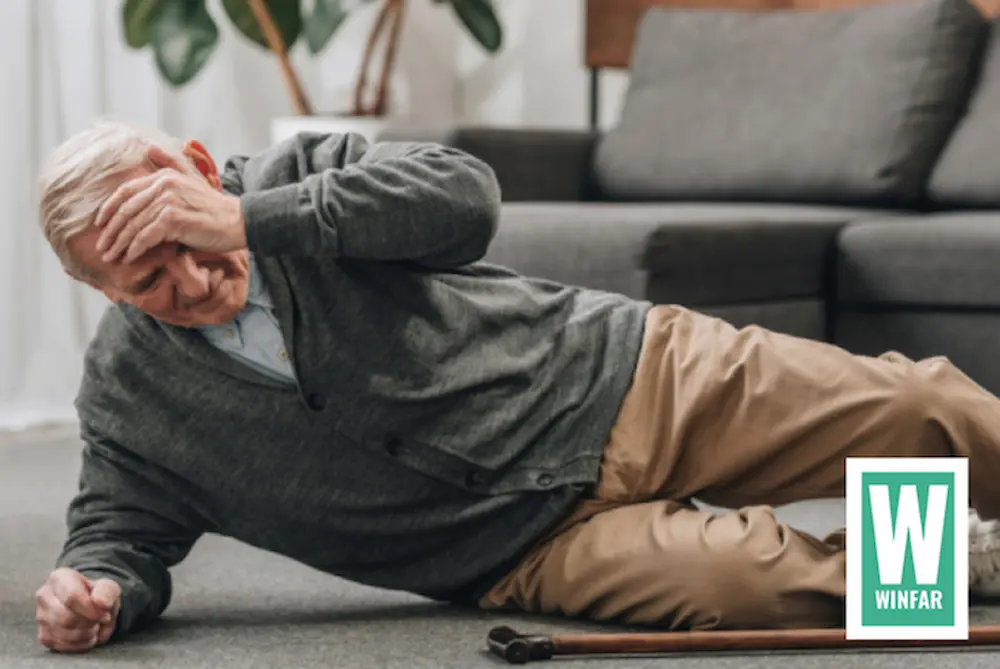If you or an older person you know has fallen, you’re not alone. The risk of falling and fall-related problems rises with age. Each year, millions of older people, those 65 and older, fall. Statistically, that’s one out of every four – and, less than half tell their doctor.
Worse still, the probability of falling again doubles after your first fall. Why?
Because, many people who fall, even if they’re not injured, become afraid of falling again. The fear of falling becomes more common as people age, even among those who haven’t fallen. It can even lead older people to avoid activities such as walking, shopping, or taking part in social activities. This fear literally debilitates. But it doesn’t have to be that way.
Falling is not something to be ashamed of. It is more often than not the consequence of a number of unaddressed risk factors.
Most falls can be prevented. And there are some simple things you can do to keep yourself from falling. But, very importantly, there are also some simple safety techniques you can learn for how to get up from a fall. Knowing what to do if you were to fall – and practicing ahead of time, is very empowering. Giving the confidence you need to help yourself out of the situation and minimise injuries. [Learn more: read our article “How to get up from a fall”]
So, what conditions increase your risk of falling?
Scientists have linked several personal risk factors to falling, including muscle weakness, problems with balance and gait, and blood pressure that drops too much when you get up from lying down or sitting.
These are called risk factors. Most of these risk factors can be fairly easily addressed to help prevent falls. If you take care of your overall health, you may be able to lower your chances of falling. Most of the time falls and accidents don’t “just happen.”
Most common risk factor:
- Lower body weakness
- Difficulties with walking and balance
- Vitamin D deficiency (that is, not enough vitamin D in your system)
- Use of certain medicines, such as tranquilizers, sedatives, or antidepressants. Even some over-the-counter medicines can affect balance and how steady you are on your feet.
- Vision or hearing problems
- Foot pain or poor footwear
- Your home environment: uneven steps, slippery floors, poorly lit walkways and throw rugs or clutter that can be tripped over.
Here are a few tips to help you avoid falls and broken bones: Most falls are caused by a combination of these risk factors. The more risk factors a person has, the greater their chances of falling.
What you can do to prevent falls?
1. Talk to Your Doctor:
– Ask your doctor to evaluate your risk for falling and talk with them about specific things you can do.
– Ask your doctor to review your medicines. Learn more about the side effects of any medicine you take. If a drug makes you sleepy or dizzy, tell your
doctor or pharmacist.
– Ask your doctor about taking vitamin D and calcium supplements. Getting enough calcium and vitamin D can help keep your bones strong.
It doesn’t prevent the fall, but it does reduce the damage.
– Always tell your doctor if you have fallen since your last checkup, even if you aren’t hurt when you fall.
2. Stay physically active.
Ask your doctor or caregiver to help you plan an exercise program that is right for you. These exercises do not need to be intense or intimidating.
Some can even be done seated. But they do increase your confidence, your strength, and mobility.
Try to get at least 150 minutes per week of physical activity.
3. Have your eyes and hearing tested regularly. Even small changes in sight and hearing may cause you to fall. So you need to have both checked at least once a year, and be sure to update your eyeglasses and hearing aid, if needed.
If you have bifocal or progressive lenses, you may want to get a pair of glasses with only your distance prescription for outdoor activities, such as walking. Sometimes these types of lenses can make things seem closer or farther away than they really are.
4. Get enough sleep. If you are sleepy, you are more likely to fall.
5. Stand up slowly. Getting up too quickly can cause your blood pressure to drop. That can make you feel wobbly.
Get your blood pressure checked whenever you visit your doctor, and be honest with them about any dizziness you may experience
6. If you need help feeling steady when you walk, use an assistive device.
And, If your doctor tells you to use a cane or walker, make sure it is the right product and size for you – and that the wheels roll smoothly. It might even be helpful to ask a specialist to teach you how to use them safely.
7. Make Your home safer
Assistive devices include more than just canes, walkers, and rollators. Consider using the following in your home:
- Handrails for both sides of stairways
- Nonslip treads for bare-wood steps
- A raised toilet seat or one with armrests
- Add grab bars inside and outside your tub or shower and next to the toilet.
- A sturdy plastic seat for the shower or tub
- A hand-held shower nozzle for bathing while sitting down
Make sure all walkways are well lit and clear of anything you can trip over. Motion-sensitive lighting is always helpful, especially for the nightly bathroom visit. And wear non-skid, rubber-soled, low-heeled shoes, or lace-up shoes with non-skid soles that fully support your feet. Learn more: Read our article on home safety.
Related article: How to get up from a fall.
Now that you have addressed all the risk factors that reduce your potential for falling, we highly recommend our related article, “What to do if you fall”.
Preparation is key. Knowing what to do if you were to fall – and practicing ahead of time, is very empowering.
If you have made the necessary preparations for this situation, then you will know what to do IN the situation. It makes a big difference, knowing that help is at hand and everybody is informed and prepared.
DISCLAIMER: This website does not provide medical advice. This information, including text, graphics, images, and other material contained on this website is for information purposes only. No material on this site is intended to be a substitute for professional medical advice, diagnosis, or treatment. Always seek the advice of your physician or other qualified health care provider with any questions you may have regarding a medical condition or treatment before undertaking a new health regime, and never disregard professional medical advice or delay in seeking it because of something you have read on this website.
Sources:
https://www.nia.nih.gov/health/prevent-falls-and-fractures
Falls on CDC
https://www.mayoclinic.org/healthy-lifestyle/healthy-aging/in-depth/fall-prevention/art-20047358
https://www.betterhealth.vic.gov.au/health/healthyliving/falls-prevention-at-home
https://www.hopkinsmedicine.org/health/wellness-and-prevention/fall-prevention-exercises
https://www.healthhub.sg/live-healthy/1414/tips-on-fall-prevention

